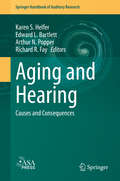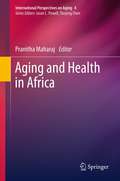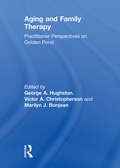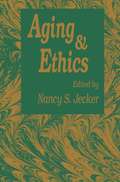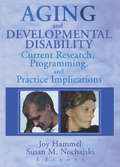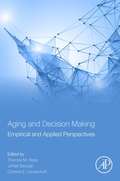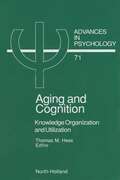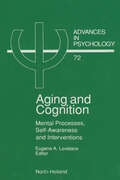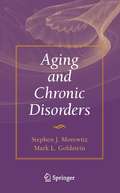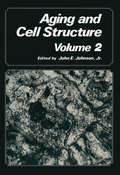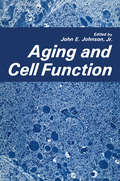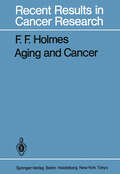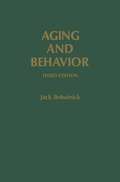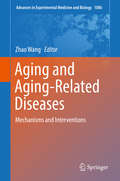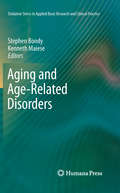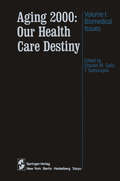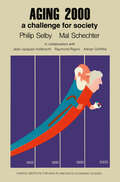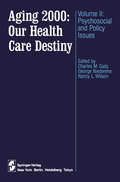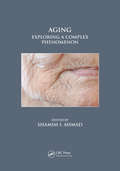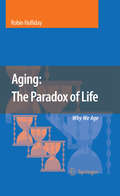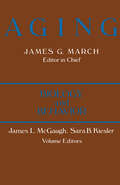- Table View
- List View
Aging and Hearing: Causes and Consequences (Springer Handbook of Auditory Research #72)
by Karen S. Helfer Edward L. Bartlett Arthur N. Popper Richard R. FaySince the first edition of the Aging Auditory System volume (in 2009), there has been a tremendous amount of research in basic, translational, and clinical sciences related to age-related changes in auditory system structure and function. The new research has been driven by technical and conceptual advances in auditory neuroscience at multiple levels ranging from cells to cognition. The chapters in Aging and Hearing: Causes and Consequences span a broad range of topics and appeal to a relatively wide audience. Our goal in this volume is to put together state-of-the-art discussions about new developments in aging research that will appeal to a broad audience, serving as an important update on the current state of research on the aging auditory system. This update includes not only the recent research, but also consideration of how human and animal studies or translational and basic research are working in tandem to advance the field. This new edition is a natural complement to the previous SHAR volume on the aging auditory system edited by Gordon-Salant, Frisina, Popper, and Fay.The target audience for this volume will be graduate students, researchers, and academic faculty from a range of disciplines (psychology, hearing science/audiology, physiology, neuroscience, engineering). It also will appeal to clinical audiologists as well as to researchers working in the hearing device industry. Individuals who attend conferences sponsored by the Association for Research in Otolaryngology, Acoustical Society of America, Auditory Cognitive Neuroscience Society, American Auditory Society, Society for Neuroscience, American Speech, Language and Hearing Association, and the American Academy of Audiology (among others) are likely to find value in the volume.
Aging and Health in Africa (International Perspectives on Aging #4)
by Pranitha MaharajPopulation aging is a matter of global concern. It often occurs in tandem with changes in the health profile of the population. In Africa, many countries are already facing a high burden of communicable diseases. However, as more and more children survive childhood and move on to adult years and old age they are also more likely to experience health problems associated with the aging process. Population aging in Africa is occurring in the context of high levels of poverty, changing family structures, an immense disease burden, fragile health systems and weak or poorly managed government institutions. This book shows that aging is likely to lead to increased social and economic demands for the continent. However, most national governments in Africa have not begun to address the issue of how to respond effectively to the needs of the older population. This will require a better understanding of the socio-economic and demographic situation of the older population in Africa. This book fills the gaps that exist by exploring the social realities of population aging in Africa. It also focuses on the policy and programmatic responses, gaps and future challenges related to aging across the continent.
Aging and Family Therapy: Practitioner Perspectives on Golden Pond
by George Hughston Victor Christopherson Marilyn BojeanEnhance the intervention strategies you use in therapy with older adults and their families. This significant new book provides practitioners with information, insight, reference sources, and other valuable tools that will contribute to more effective intervention with the elderly and their families. Outstanding scholars have contributed original material that addresses the major issues in treating the elderly from the practitioner’s point of view; the biological, psychological, social, and spiritual concerns of the aged are examined in order to formulate a systemic and comprehensive treatment plan. Destined to become a classic in a challenging new area of psychotherapy, the unique Aging and Family Therapy promises to guide and inform practitioners who will be called upon to provide assistance to the increasing number of older adults who will be in need of mental health services.
Aging and Family Therapy: Practitioner Perspectives on Golden Pond
by George Hughston Victor Christopherson Marilyn BojeanEnhance the intervention strategies you use in therapy with older adults and their families. This significant new book provides practitioners with information, insight, reference sources, and other valuable tools that will contribute to more effective intervention with the elderly and their families. Outstanding scholars have contributed original material that addresses the major issues in treating the elderly from the practitioner’s point of view; the biological, psychological, social, and spiritual concerns of the aged are examined in order to formulate a systemic and comprehensive treatment plan. Destined to become a classic in a challenging new area of psychotherapy, the unique Aging and Family Therapy promises to guide and inform practitioners who will be called upon to provide assistance to the increasing number of older adults who will be in need of mental health services.
Aging And Ethics: Philosophical Problems in Gerontology (Contemporary Issues in Biomedicine, Ethics, and Society)
by Nancy S. JeckerThe Aging Self and the Aging Society Ethical issues involving the elderly have recently come to the fore. This should come as no surprise: Since the turn of the century, there has been an eightfold in crease in the number of Americans over the age of sixty five, and almost a tripling of their proportion to the general population. Those over the age of eighty-five- the fastest growing group in the country-are twenty one more times as numerous as in 1900. Demographers expect this trend to accelerate into the twenty-first century. The aging of society casts into vivid relief a num ber of deep and troubling questions. On the one hand, as individuals, we grapple with the immediate experience of aging and mortality and seek to find in it philosophical or ethical significance. We also wonder what responsi bilities we bear toward aging family members and what expectations of others our plans for old age can reasona bly include. On the other hand, as a community, we must decide: What special role, if any, do older persons occupy in our society? What constitutes a just distribution of medical resources between generations? And, How can institutions that serve the old foster imperiled values, such as autonomy, self-respect, and dignity? Only recently have we begun to explore these themes, yet already a rich and fruitful literature has grown up around them.
Aging and Developmental Disability: Current Research, Programming, and Practice Implications
by Joy Hammel Susan NochajskiAging and Developmental Disability: Current Research, Programming, and Practice Implications explores research findings and their implications for practice in relation to normative and disability-related aging experiences and issues. This valuable book discusses the effectiveness of specific interventions targeted toward aging adults with developmental disabilities such as Down's Syndrome, cerebral palsy, autism, and epilepsy, and offers suggestions for practice and future research in this area.
Aging and Developmental Disability: Current Research, Programming, and Practice Implications
by Joy Hammel Susan NochajskiAging and Developmental Disability: Current Research, Programming, and Practice Implications explores research findings and their implications for practice in relation to normative and disability-related aging experiences and issues. This valuable book discusses the effectiveness of specific interventions targeted toward aging adults with developmental disabilities such as Down's Syndrome, cerebral palsy, autism, and epilepsy, and offers suggestions for practice and future research in this area.
Aging and Decision Making: Empirical and Applied Perspectives
by Thomas M. Hess JoNell Strough Corinna E. LöckenhoffDecisions large and small play a fundamental role in shaping life course trajectories of health and well-being: decisions draw upon an individual's capacity for self-regulation and self-control, their ability to keep long-term goals in mind, and their willingness to place appropriate value on their future well-being. Aging and Decision Making addresses the specific cognitive and affective processes that account for age-related changes in decision making, targeting interventions to compensate for vulnerabilities and leverage strengths in the aging individual. This book focuses on four dominant approaches that characterize the current state of decision-making science and aging - neuroscience, behavioral mechanisms, competence models, and applied perspectives. Underscoring that choice is a ubiquitous component of everyday functioning, Aging and Decision Making examines the implications of how we invest our limited social, temporal, psychological, financial, and physical resources, and lays essential groundwork for the design of decision supportive interventions for adaptive aging that take into account individual capacities and context variables.Divided into four dominant approaches that characterize the current state of decision-making science and aging neuroscienceExplores the impact of aging on the linkages between cortical structures/functions and the behavioral indices of decision-makingExamines the themes associated with behavioral approaches that attempt integrations of methods, models, and theories of general decision-making with those derived from the study of agingDetails the changes in underlying competencies in later life and the two prevailing themes that have emerged—one, the general individual differences perspective, and two, a more clinical focus
Aging and Cognition: Knowledge Organization and Utilization (ISSN #Volume 71)
by T. M. HessDuring the past two decades, there has been a dramatic increase in interest in the study of aging-related changes in cognitive abilities. In this volume researchers from a variety of theoretical perspectives discuss adult age differences in a wide range of cognitive skills. Of special interest is the extent to which aging effects on performance are related to variations in the representation, organization, and utilization of knowledge, broadly defined. Recent research and theory in the field of aging has emphasized the need to examine such processes more closely in order to provide a more complete understanding of aging effects on cognitive behavior.
Aging and Cognition: Mental Processes, Self-Awareness and Interventions (ISSN #Volume 72)
by E. A. LovelacePresented in this volume is a discussion of current literature and theoretical issues relating to three aspects of late-life age-related cognitive change. Firstly, evidence regarding aging and the basic mental processes of attention, motor control, memory, language, problem-solving, and intelligence are presented. Secondly, the role of personal traits such as personality and self-efficacy in the aging of cognitive function are developed, along with self-awareness of cognitive processes and age changes in the monitoring of these processes. Thirdly, consideration is given to the study of interventions to delay or remediate the cognitive declines of aging.
Aging and Chronic Disorders
by Stephen J. Morewitz Mark L. GoldsteinFocusing on the most prevalent conditions affecting seniors - including diabetes, cardiovascular disease, osteoporosis, arthritis, and fibromyalgia - Morewitz and Goldstein analyze the impact of chronic disease on aging. Separate chapters are devoted to cognitive changes, psychological problems, and trends in health care utilization, and all chapters are amplified by current research findings.
Aging and Cell Structure: Volume 2
by John E. JohnsonAlthough thousands of articles and hundreds of books on aging have been published, only a small percentage of this material has dealt with anatomy, particularly at the fine structural level. It was with this in mind that Aging and Cell Structure was conceived. Volume 1 of Aging and Cell Structure was published in 1981 and represented a current compilation of information, concentrating at the electron microscopic level, on morphological changes which occur in cells and tissues as they age. The present volume completes the two-volume set. While Volume 1 highlighted structural changes occurring in the aging nervous system, Volume 2 centers its efforts on studies of in vitro aging. Chapters on other subjects are included as well. These include age-related changes seen in neuromuscular junctions, oral tissues, and the pancreas. Although these two volumes represent a very small part of the published infor mation on experimental gerontology, their approach is rather unique because they focus on anatomy, perhaps the most basic of all the biomedical sciences. Because many dif ferent tissue types are examined, we begin to see recurrent, definitive patterns in the aging cell which may not be fully apparent from studies taking one cell type at a time. This becomes even more evident in the present volume where changes seen in popula tions of cells grown in culture-isolated from hormones or nervous impulses from other body areas-are found to be similar to those changes found in vivo.
Aging and Cell Function
by John E. JohnsonThe aging process, like most (all?) things in the universe, is a puzzle. It is such a fundamental occurrence, common to all living things, that it ironically may be the most complicated and perplexing puzzle to solve. There are, of course, puzzles sufficient in number to occupy all the scientists and philosophers who have ever lived a thousand times over. Yet what other phenomenon affects everyone of us as much as growing old? Curiosity about the ubiquity of aging as a phenomenon, boosted perhaps by an only natural fear of that same phenomenon as an undeniable manifes tation of our own mortality, has led to the compilation of data on the aging process, which have accumulated as rapidly as the elderly who might benefit from those data. Most of the scientific data on the biology of aging are at the biochemical and physiological levels, while comparatively little information has been avail able at the anatomical level. Because of this, a two-volume set called Aging and Cell Structure was conceived, the first volume having been published in 1981 and the second volume being published concurrently with the present one on cell function. The emphasis on training of scientists and other individuals in advanced education has, during past decades, been one of increased specialization. Not merely do we specialize in physiology, anatomy, zoology, or literature, but in glomerular filtration, synaptic junctions, tree frogs of Brazil, or English poetry of the nineteenth century.
Aging and Cancer (Recent Results in Cancer Research #87)
by F. F. HolmesThe life of a human being is finite, and all humans age (see Fries 1980). It is difficult to separate the effects of disease on organs and tissues from those expected of aging. This is particularly true for vascular and degenerative processes, for which there are no clear boundaries between aging and disease. Morbidity and mortality from heart disease and stroke are probably due both to disease and to changes of aging. For cancer, the second leading cause of death in America, the situation is quite different; cancer is clearly a disease and is not a change expected with aging. Cancer incidence increases almost logarithmically after age 40. In the United States about one-half of all cases of cancer are diagnosed after age 65, although those over 65 comprise less than one-eighth of the population. Thus, cancer is very much a disease of the elderly. There are at least two reasons for this: first, the prolonged exposure to cancer-inducing agents, and second, the waning power of immune defenses against cancer.
Aging and Biological Rhythms (Advances in Experimental Medicine and Biology #108)
by H. V. SamisAging is one of the most serious and costly health problems in the Western world. A disproportionate amount of the available health care capability is devoted to the health care of the aged and the cost of this care is soaring. Viewed in wide perspective, aging presents two problems for the researcher's consideration. First is that of providing the most efficacious therapeutic regi mens and the best possible care for those already in their latter years. The second is to determine the cause or causes for senes cence and all its attendant problems in order to decrease the im pact of senescence on general health and well being. This volume is aimed at examining possible relationships be tween biological time structure and aging and ways by which these interrelationships might be examined in terms of both the causes of senescence and the management of health problems of the elderly. The purpose of the volume is to stir the interests of chronobiolo gists in gerontology and those of gerontologists and geriatricians in chronobiology.
Aging and Aging-Related Diseases: Mechanisms and Interventions (Advances in Experimental Medicine and Biology #1086)
by Zhao WangThis book provides an overview of recent advances in the study of aging and aging related diseases, discussing the topics at individual, organ, tissue, cell, and molecular levels. It also presents studies on the biomarkers of aging and anti-aging interventions. Aging has been becoming a global health problem. However it was not possible to determine aging as we usually diagnose a disease because there are few biomarkers for age estimation. Since ancient times, people have been seeking anti-aging substances and methods for achieving immortality, while the scientific study of aging has only existed for 100 years. This book appeals to researchers both in institutes and in pharmaceutical companies interested in further studies in this field.
Aging and Age-Related Disorders (Oxidative Stress in Applied Basic Research and Clinical Practice)
by Stephen Bondy Kenneth MaieseFeatures that characterize the aging process include the gradual accumulation of cell damage after prolonged exposure to oxidative and inflammatory events over a lifetime. In addition to the accretion of lesions, the intrinsic levels of pro-oxidant and aberrant immune responses are elevated with age. These adverse events are often further enhanced by the chronic and slow progressing diseases that characterize the senescent brain and cardiovascular system. The incidence of some disorders such as Alzheimer's disease and vascular diseases are sufficiently prevalent in the extreme elderly that these disorders can arguably be considered "normal". Aging and Aging-Related Disorders examines the interface between normal and pathological aging, and illustrates how this border can sometimes be diffuse. It explores and illustrates the processes underlying the means by which aging becomes increasingly associated with inappropriate levels of free radical activity and how this can serve as a platform for the progression of age-related diseases. The book provides chapters that examine the interactive relationship between systems in the body that can enhance or sometimes even limit cellular longevity. In addition, specific redox mechanisms in cells are discussed. Another important aspect for aging discussed here is the close relationship between the systems of the body and exposure to environmental influences of oxidative stress that can affect both cellular senescence and a cell’s nuclear DNA. What may be even more interesting to note is that these external stressors are not simply confined to illnesses usually associated with aging, but can be evident in maturing and young individuals. A broad range of internationally recognized experts have contributed to this book. Their aim is to successfully highlight emerging knowledge and therapy for the understanding of the basis and development of aging–related disorders.
Aging 2000: Volume 1: Biomedical Issues
by T. Samorajski Charles M. GaitzThe seventeenth annual symposium sponsored by the Texas Research Institute of Mental Sciences was held October 23-26, 1983, in Houston, Texas. The theme was Aging 2000: Our Health Care Destiny. This volume on biomedical aspects and a companion volume on psycho social aspects include edited versions of the presentations by about 80 speakers. Their papers were directed at practitioners, researchers, and medical educators who will be active and productive in the year 2000, and we focused on those who would influence the evolution of care of elderly persons during the next 17 years. We chose topics that would be of particular interest to teachers and current planners in the disciplines concerned with delivery of health and social services. We believe that having a core of more qualified and better trained practitioners will help the population of aged persons achieve a higher level of physical and mental health, life satisfaction and happiness, to find better coping techniques and control of environmental stresses, and to attain personal and social goals. Our Goals While preparing for the symposium we knew that the status of the art in 1983 obviously would be the base from which we would work, but we asked our speakers to give priority to future planning and directions.
Aging 2000: a challenge for society
by P. Selby M. SchecterFor age is opportunity no less Than youth itself, though in another dress, And as the evening twilight fades away The sky is filled with stars, invisible by day. Henry Wadsworth Longfellow, Morituri Salutamus We live in a society that remorselessly casts off those who are too weak, mentally or physically, to cling to the dizzy wheel of existence - a society that worships the idols of beauty, youth, and wealth whilst ruthlessly rejecting those who fall outside its narrow standards of acceptability, or exploitability. The elderly are the latest victims of an artificial life-style that tends to create artificial problems. In this respect, we have much to learn from those primitive communities that continue to revere their elders for the wisdom they have acquired in the school of life, and which have yet to make the dubious progression to a civilization that dismisses its senior members as senile old fools or a burden on taxpayers' funds. It is vital to warn developing countries of the dangers of duplicating the errors of the industrial world - of which they see only the superficial trappings that mask the iceberg of disillusionment beneath.
Aging 2000: Volume II: Psychosocial and Policy Issues
by Nancy L. Wilson GeorgeNiederehe Charles M. GaitzThe seventeenth annual symposium sponsored by the Texas Research Institute of Mental Sciences was held October 23-26, 1983, in Houston, Texas. The theme was Aging 2000: Our Health Care Destiny. This volume on social, psychological, economic, and ethical aspects and a companion volume (Volume I) on biomedical aspects include edited versions of the presentations by about 80 speakers. Their papers were directed at practitioners, researchers, and medical educators who will be active and productive in the year 2000, and we focused on those who would influence the evolution of care of elderly persons during the next 17 years. We chose topics that would be of particular interest to teachers and current planners in the disciplines concerned with delivery of health and social services. We believe that having a core of more qualified and better trained practitioners will help the population of aged persons achieve a higher level of physical and mental health, life satisfaction and happiness, find better coping techniques and control of environmental stresses, and attain personal and social goals. Our Goals While preparing for the symposium we knew that the status ofthe art in 1983 obviously would be the base from which we would work, but we asked our speakers to give priority to future planning and directions.
Aging: Exploring a Complex Phenomenon
by Shamim I. AhmadThis book is a detailed and comprehensive synthesis of the scientific study of aging. Dozens of contributions from leading scholars review various theories of aging, and molecular, cellular, biochemical and microbial aspects of aging, among just a few of the topics included. Authoritative, wide ranging and thorough, this book will act as a source for experimental design, a comprehensive description of age related diseases, and provide information of the latest molecular theories underlying their causes. Additionally, it will target industries involved in developing anti-aging drugs, post-graduate medical students, and university libraries.
Aging: Exploring a Complex Phenomenon
by Shamim I. AhmadThis book is a detailed and comprehensive synthesis of the scientific study of aging. Dozens of contributions from leading scholars review various theories of aging, and molecular, cellular, biochemical and microbial aspects of aging, among just a few of the topics included. Authoritative, wide ranging and thorough, this book will act as a source for experimental design, a comprehensive description of age related diseases, and provide information of the latest molecular theories underlying their causes. Additionally, it will target industries involved in developing anti-aging drugs, post-graduate medical students, and university libraries.
Aging: Why We Age
by Robin HollidayFor centuries people have puzzled over the inevitability of human aging. At the end of the 20th century a remarkable scientific discovery emerged, based on a series of important interconnected insights over quite a long period of time. The aim of this book is to dispel ignorance by explaining in non-technical language what are the reasons for aging and the myth of excessive prolongation of life.
Aging: Biology and Behavior
by James L. McGaugh Sara B. KieslerAging: Biology and Behavior addresses behavioral changes in aging related to biological processes, focusing on the nature of changes in brain plasticity, factors influencing life-span, and environmental and social influences on health in the elderly. This book is divided into four main topics—longevity, aging, and mortality; aging brain and behavior; cognitive and social functioning; and health. In these topics, this publication specifically discusses the longevity in primates, life-span extension, environment and biology in aging, and some economic implications of life-span extension. The neurobiological basis of age-related changes in neuronal connectivity, aging and brain plasticity, and cognitive functioning in the elderly are also elaborated. This text likewise covers the life changes and disease in elderly populations, social stress and mental disorders in the elderly, and perspective of social epidemiology. This volume is a useful source to clinicians and students examining possible social and behavioral science research perspectives on aging.
